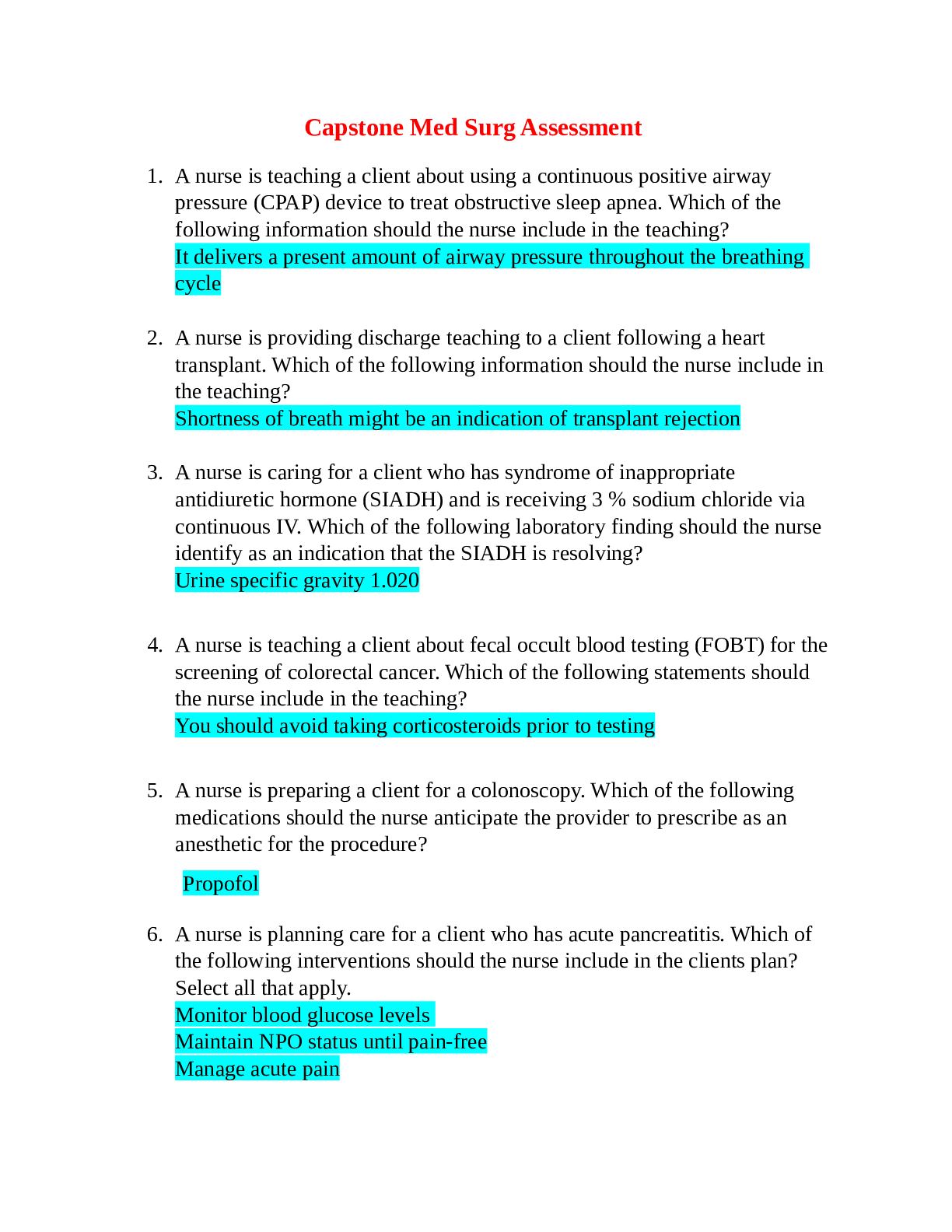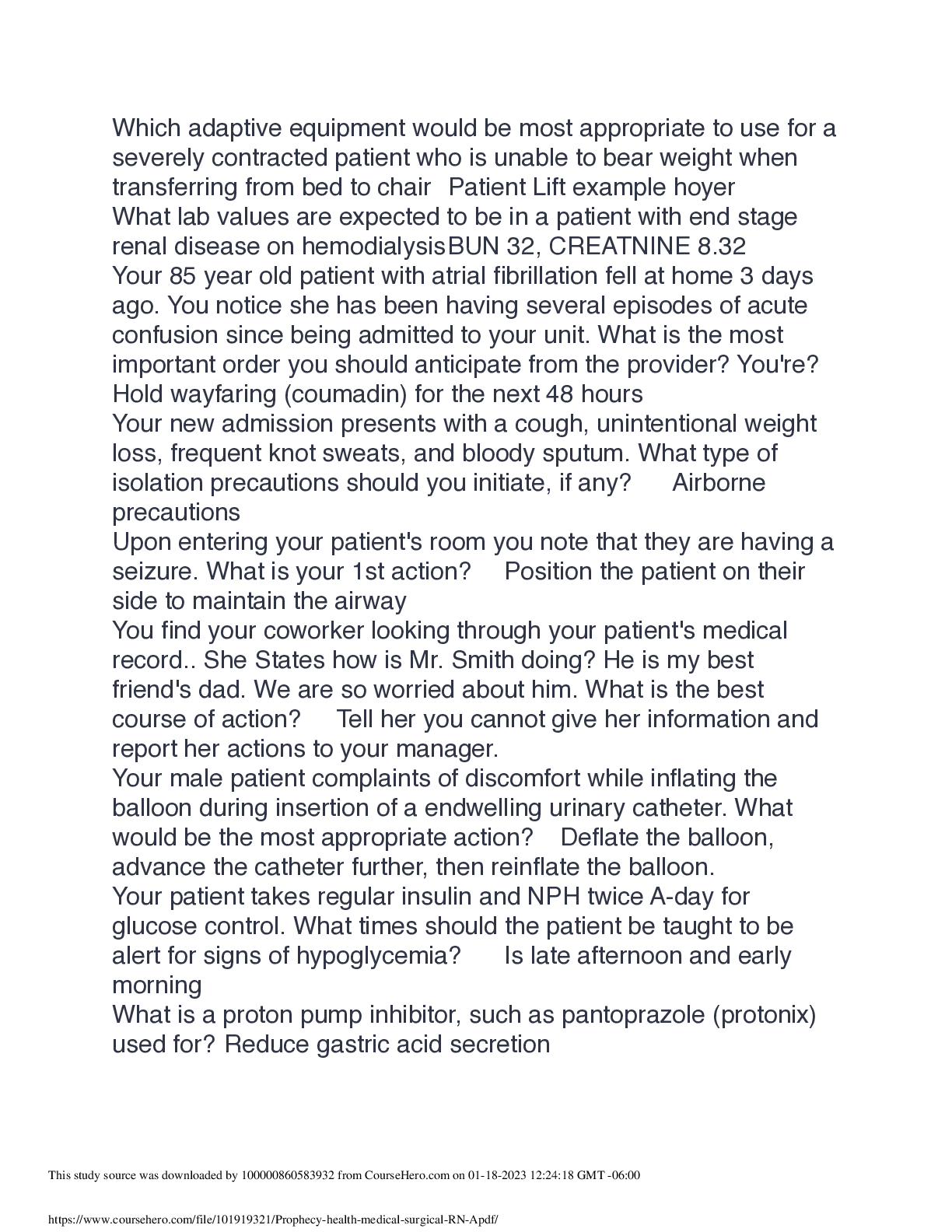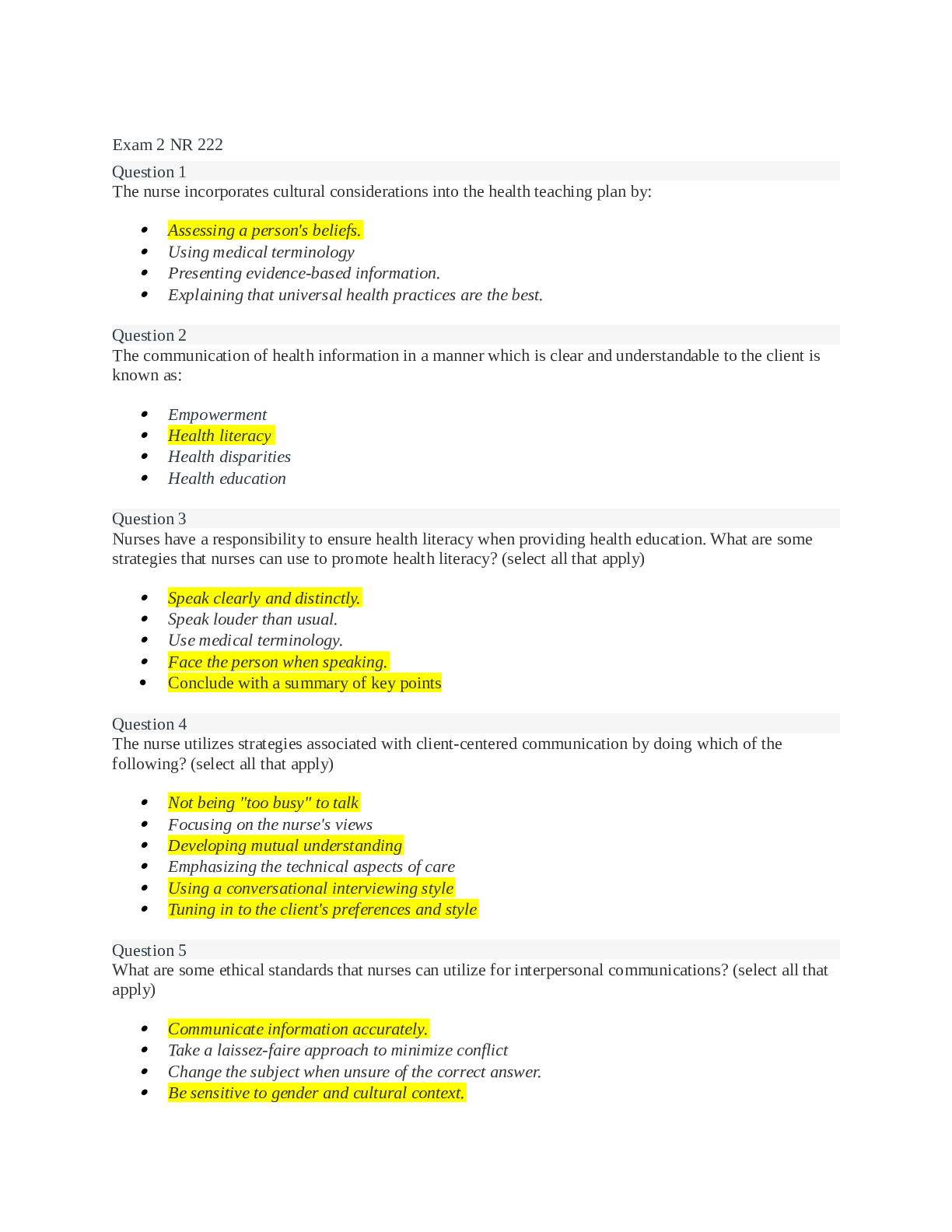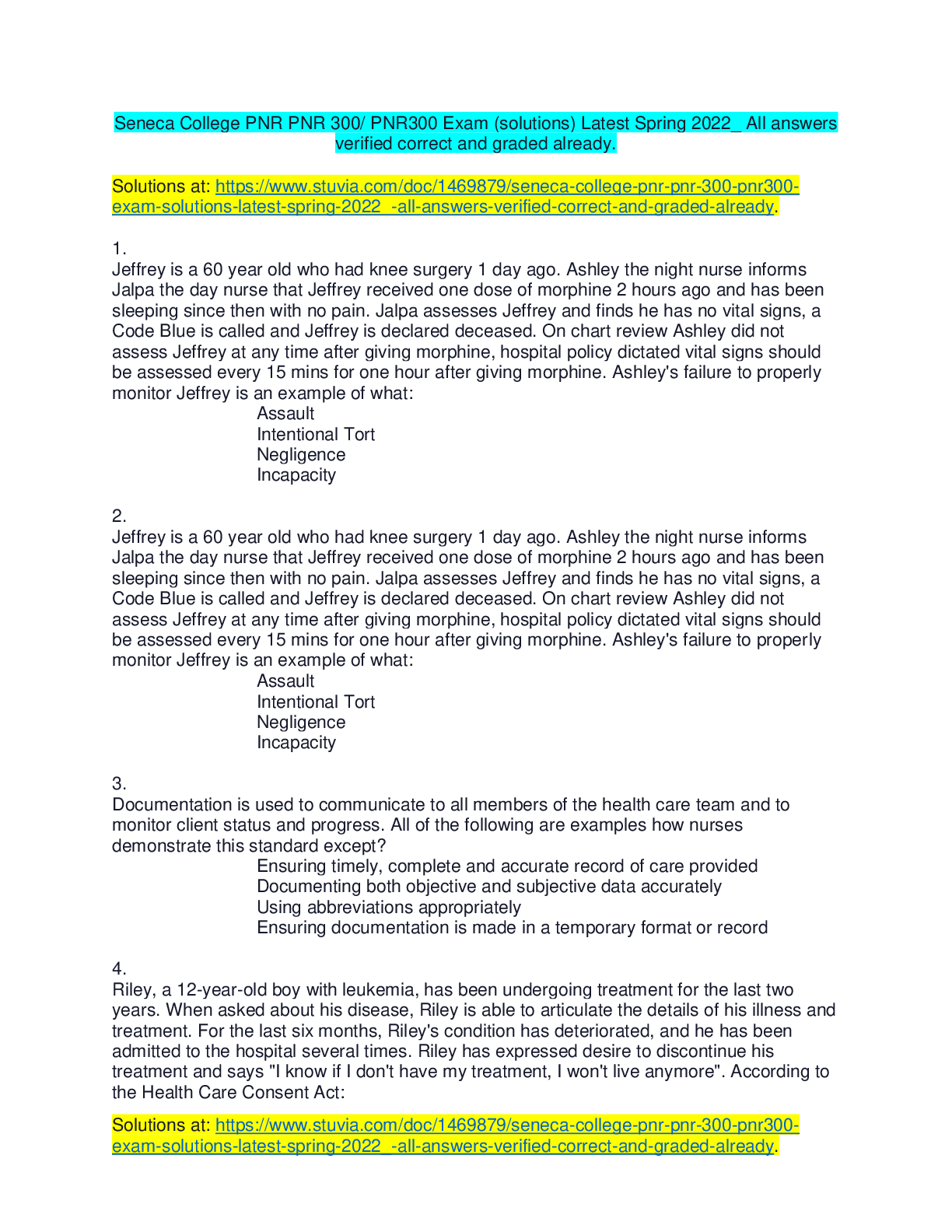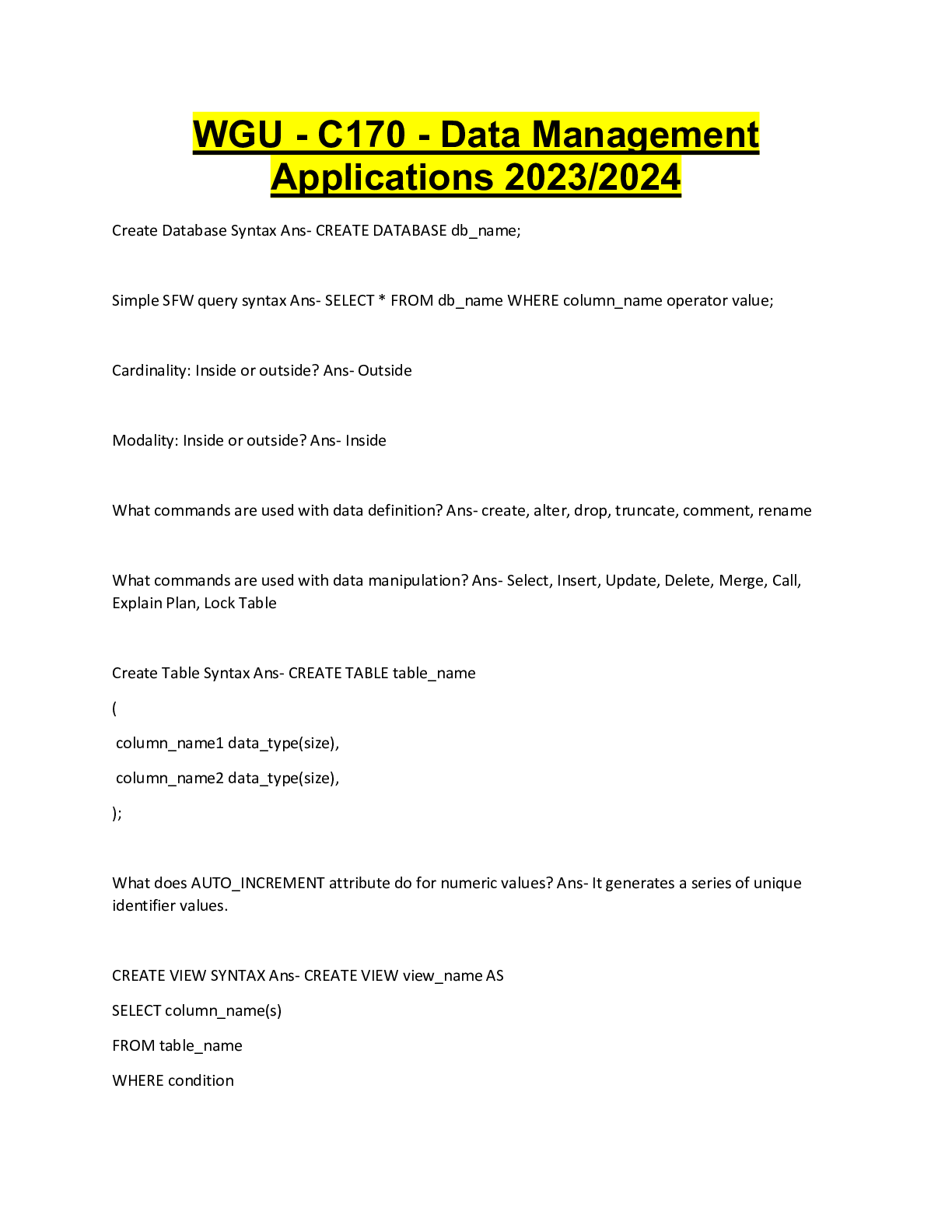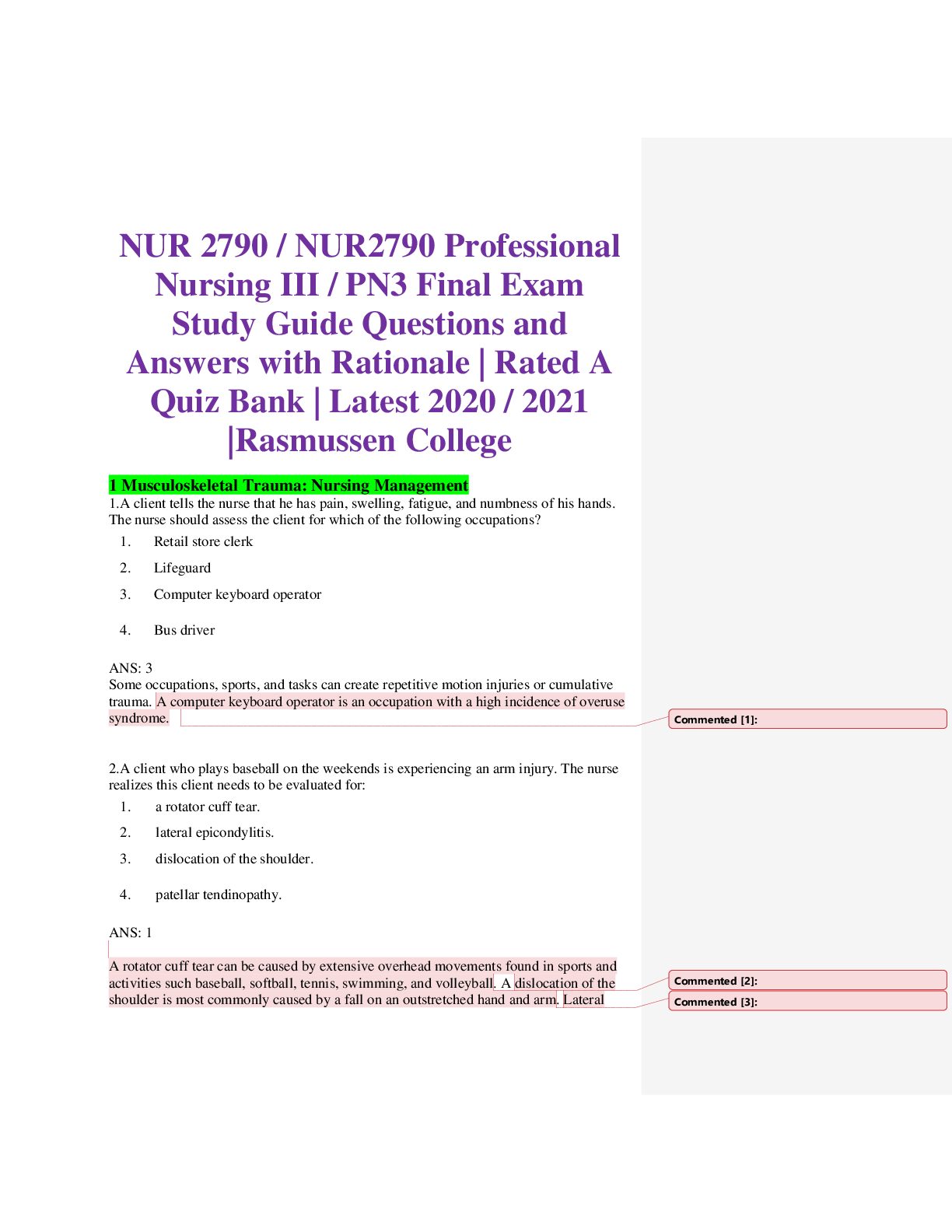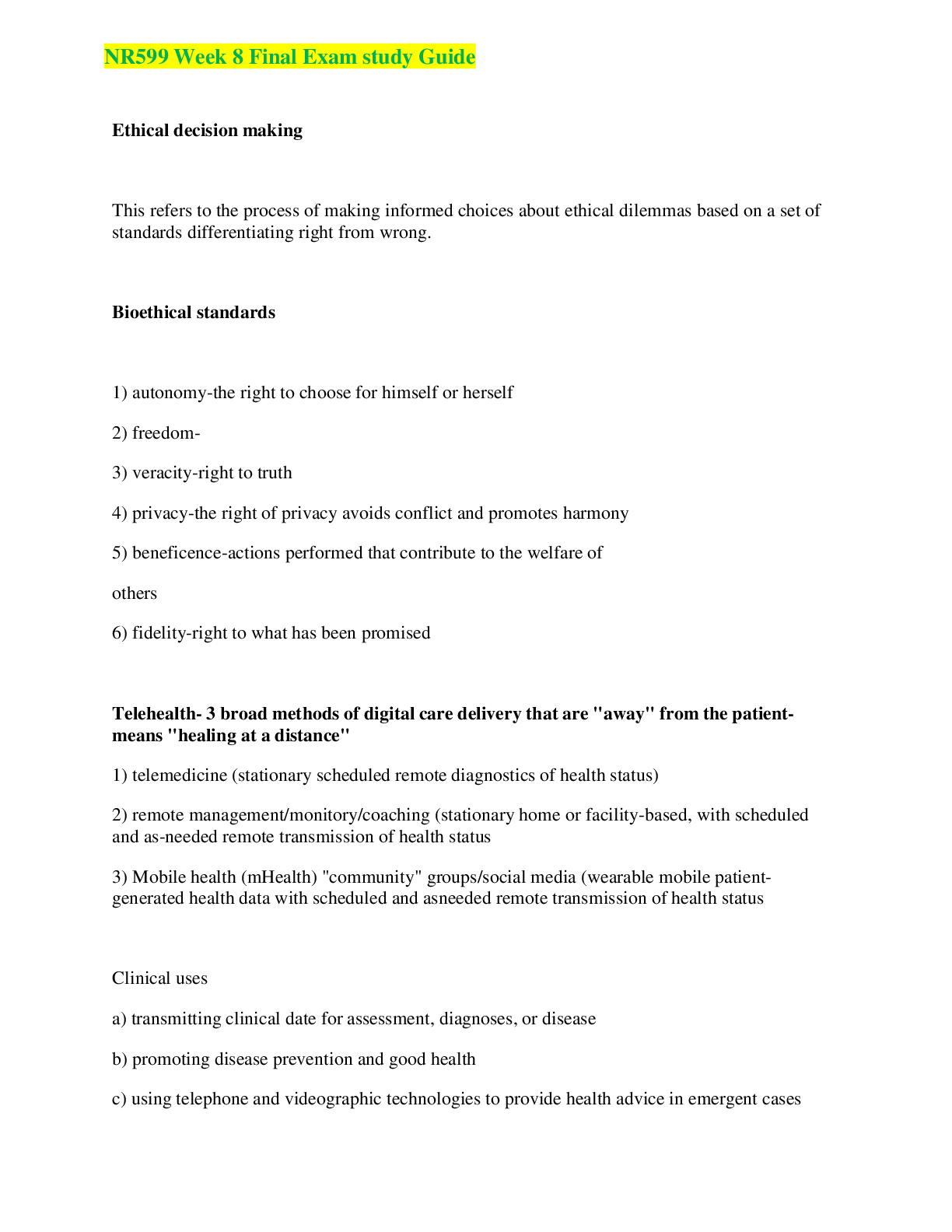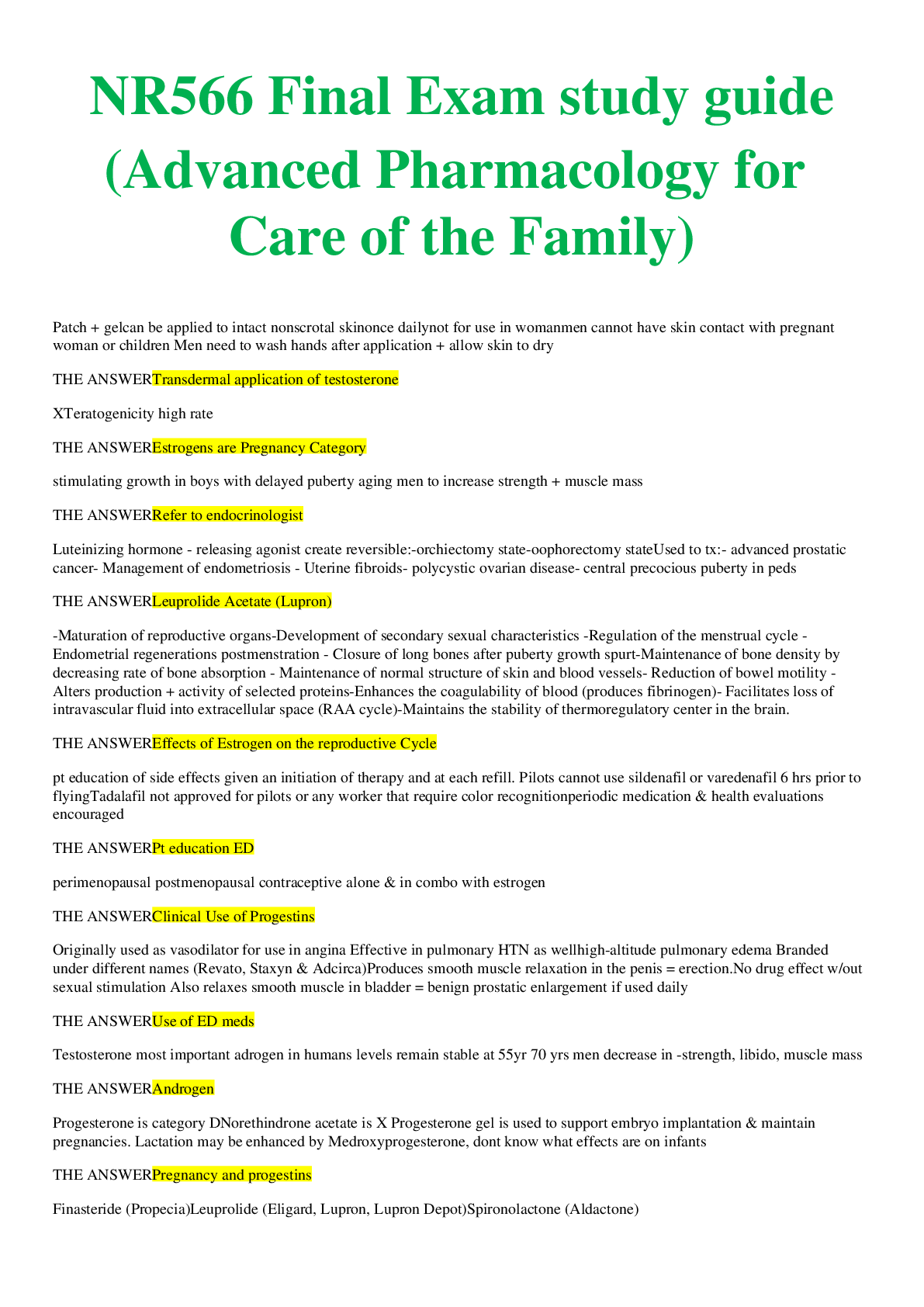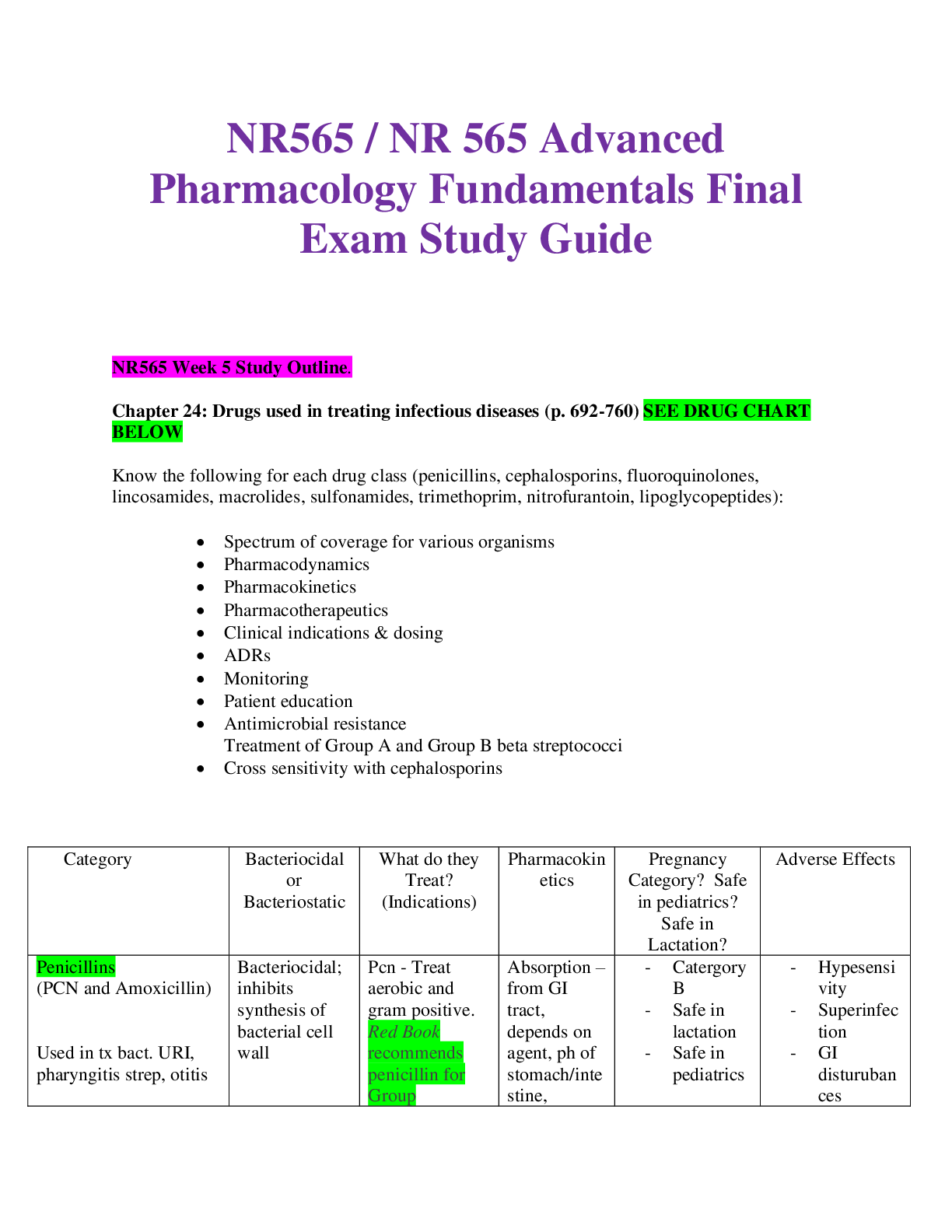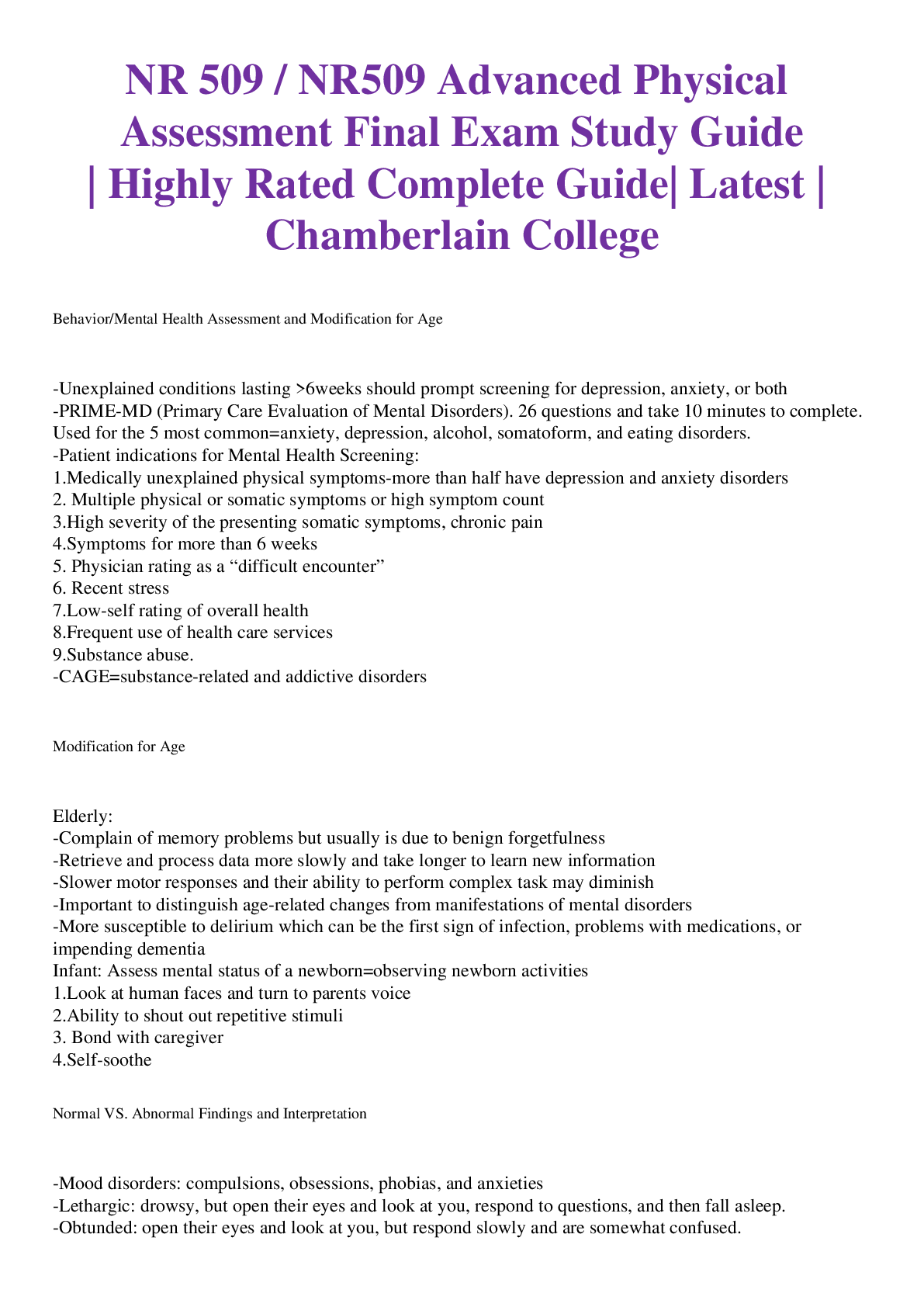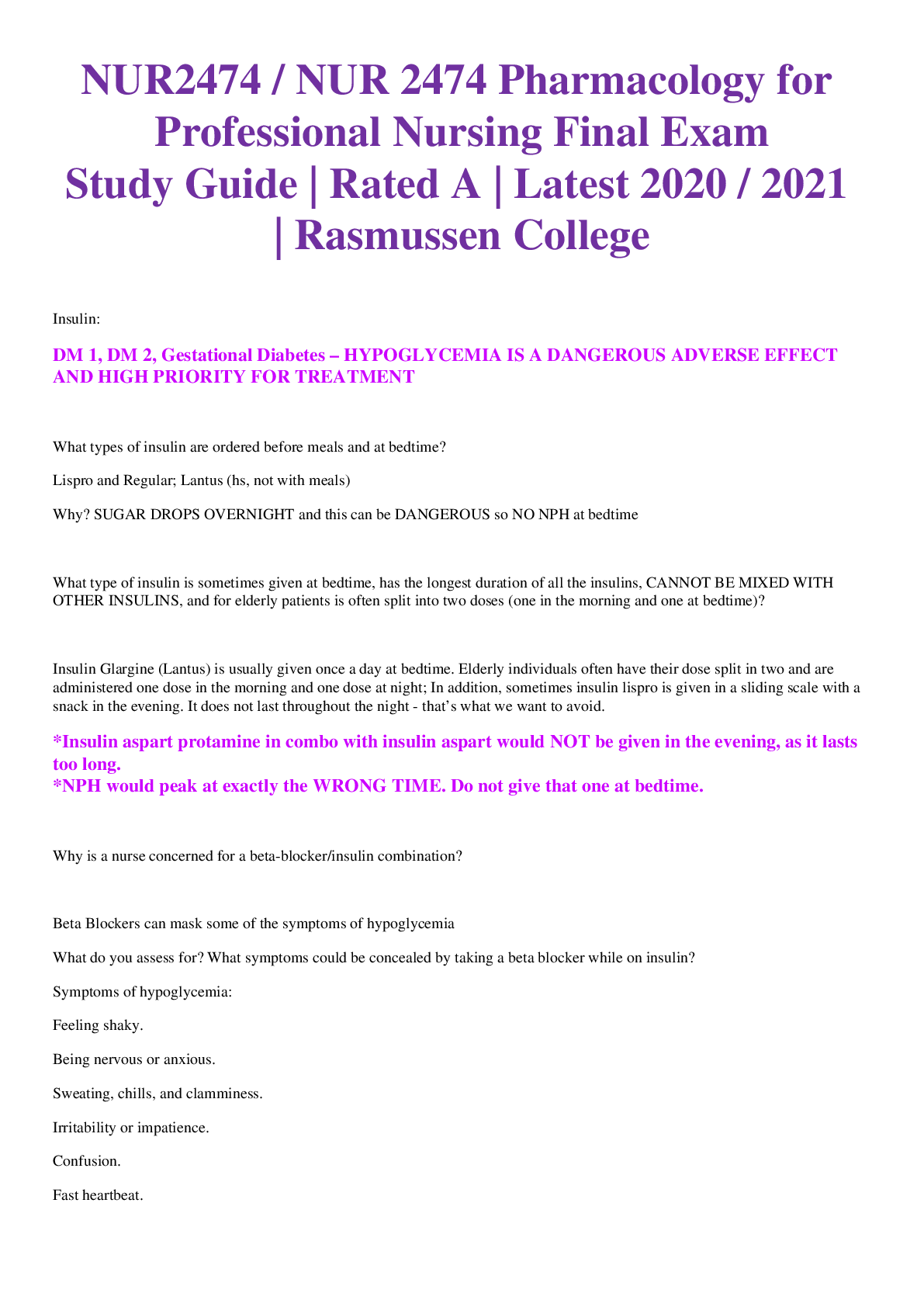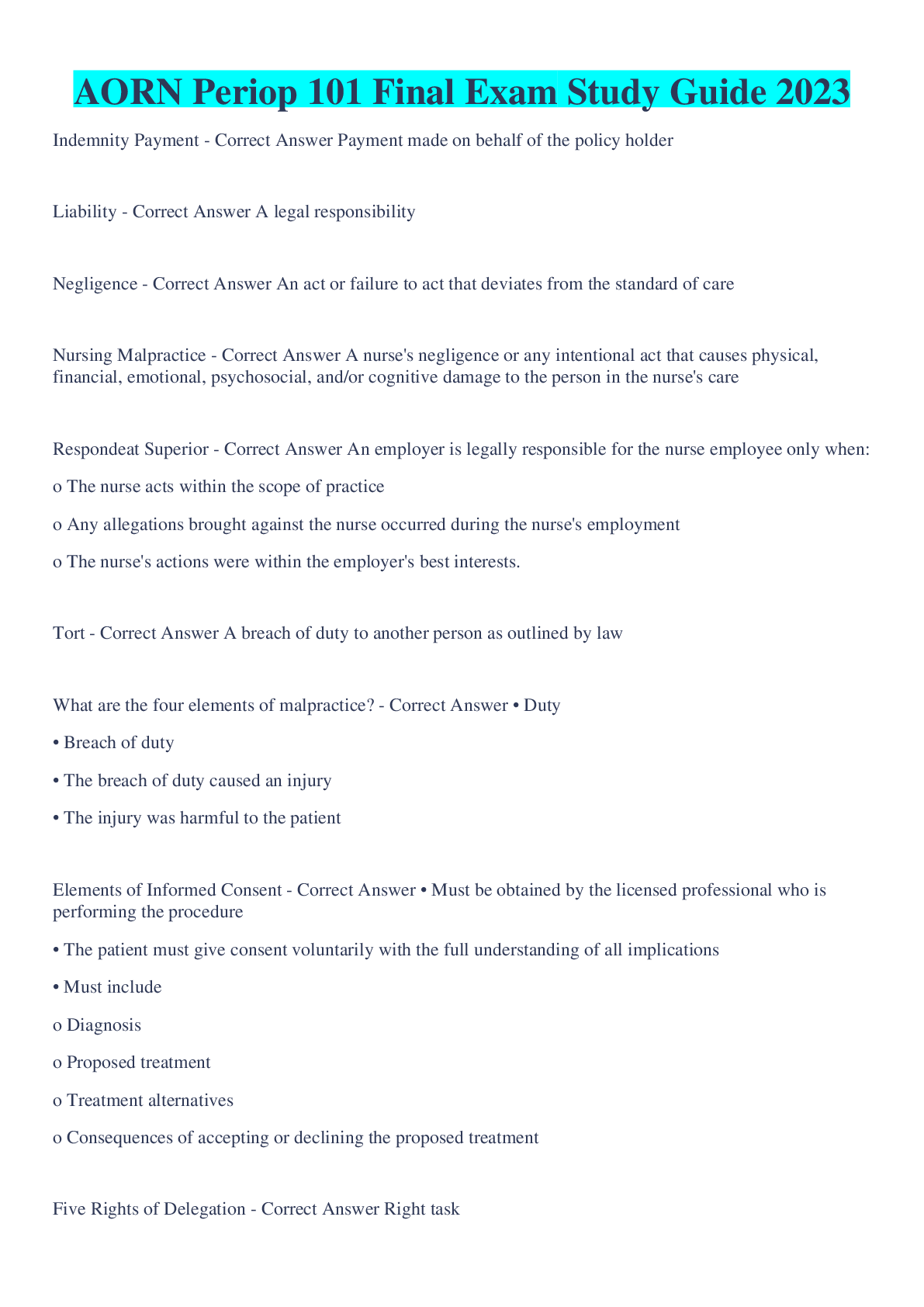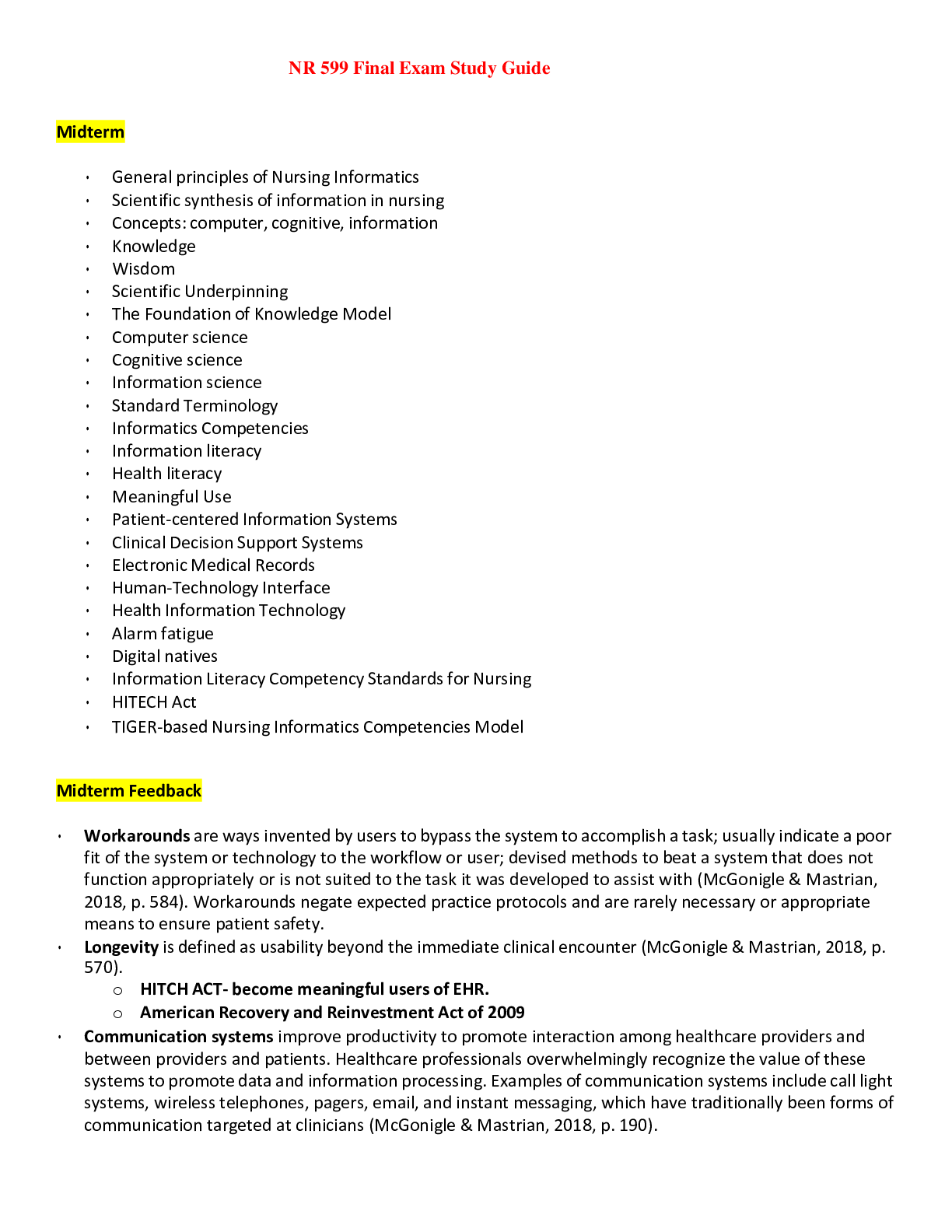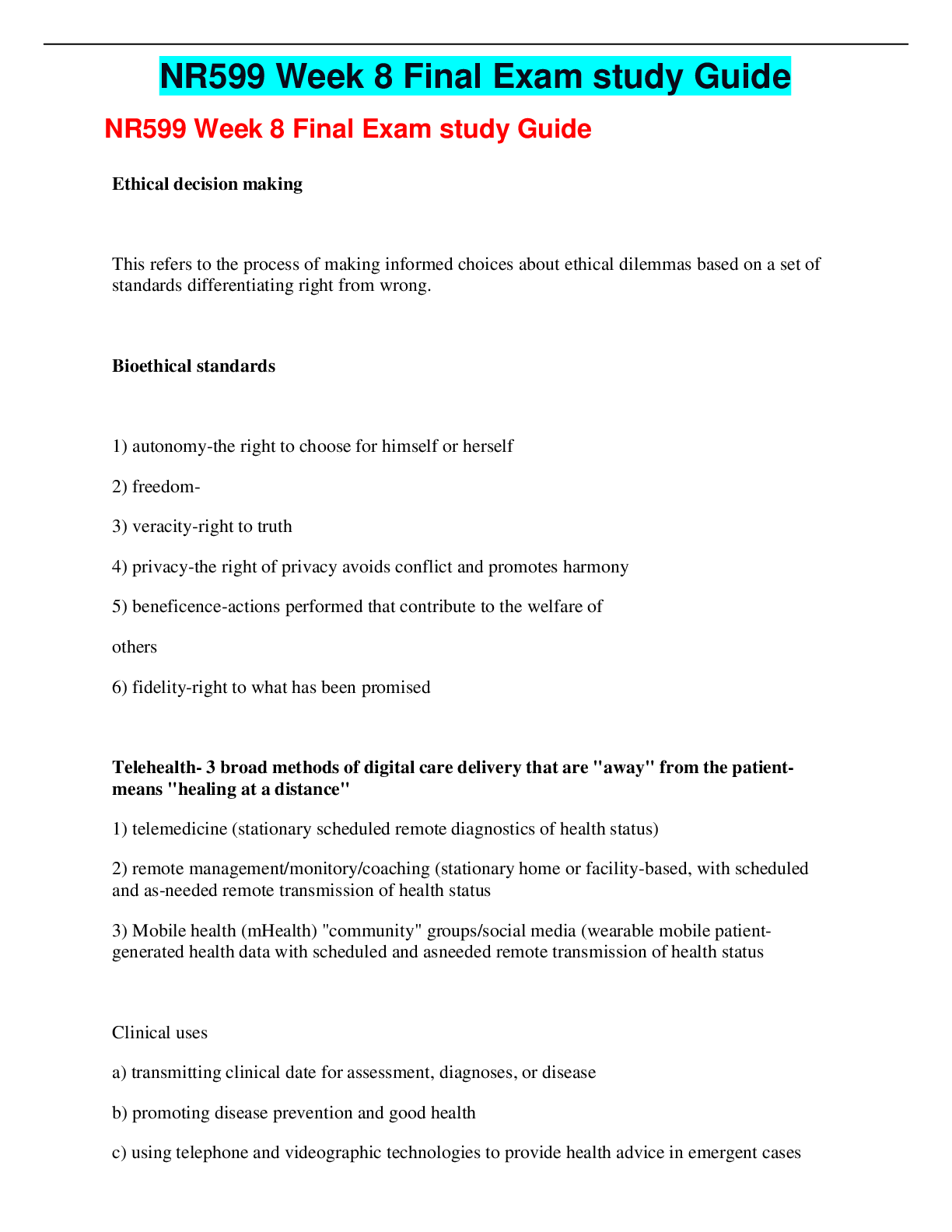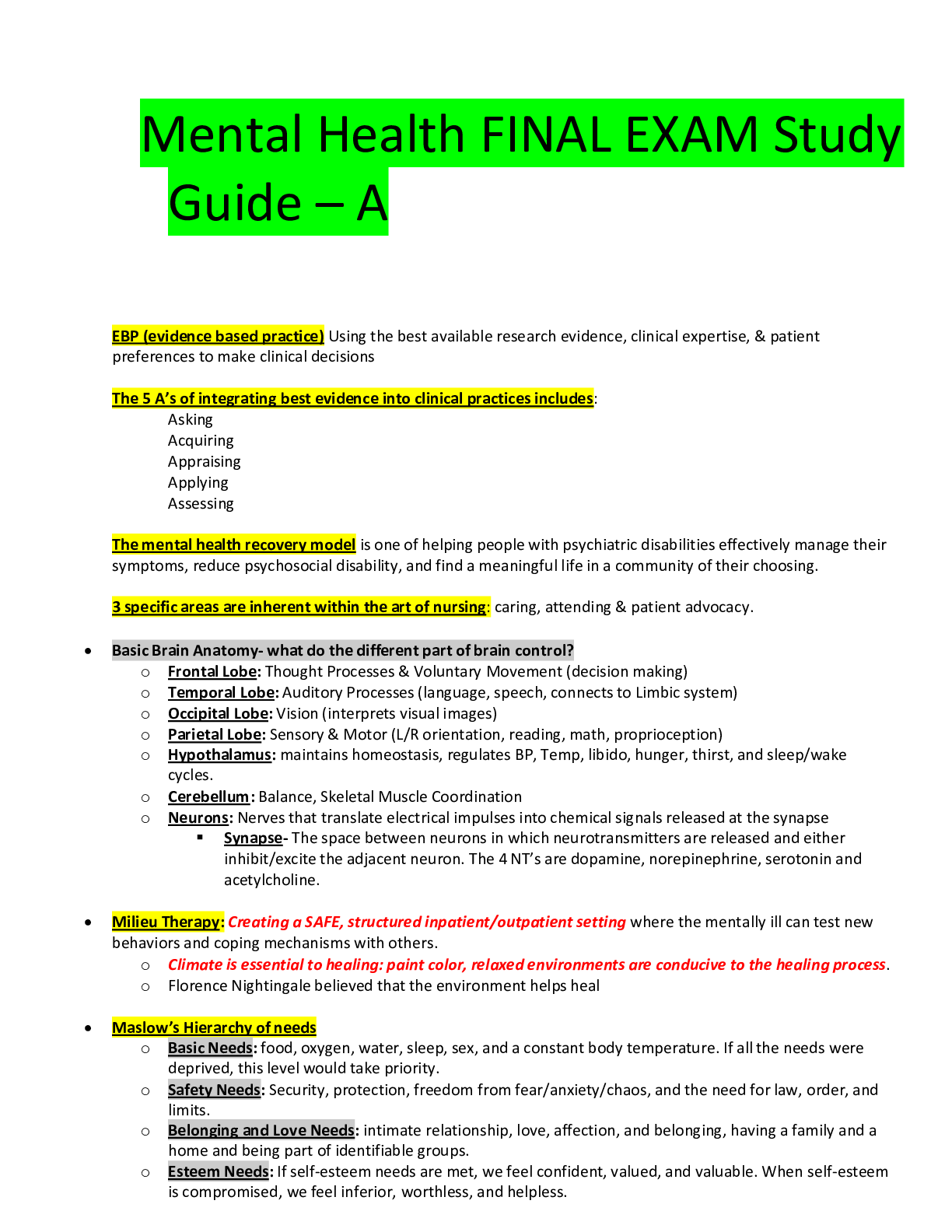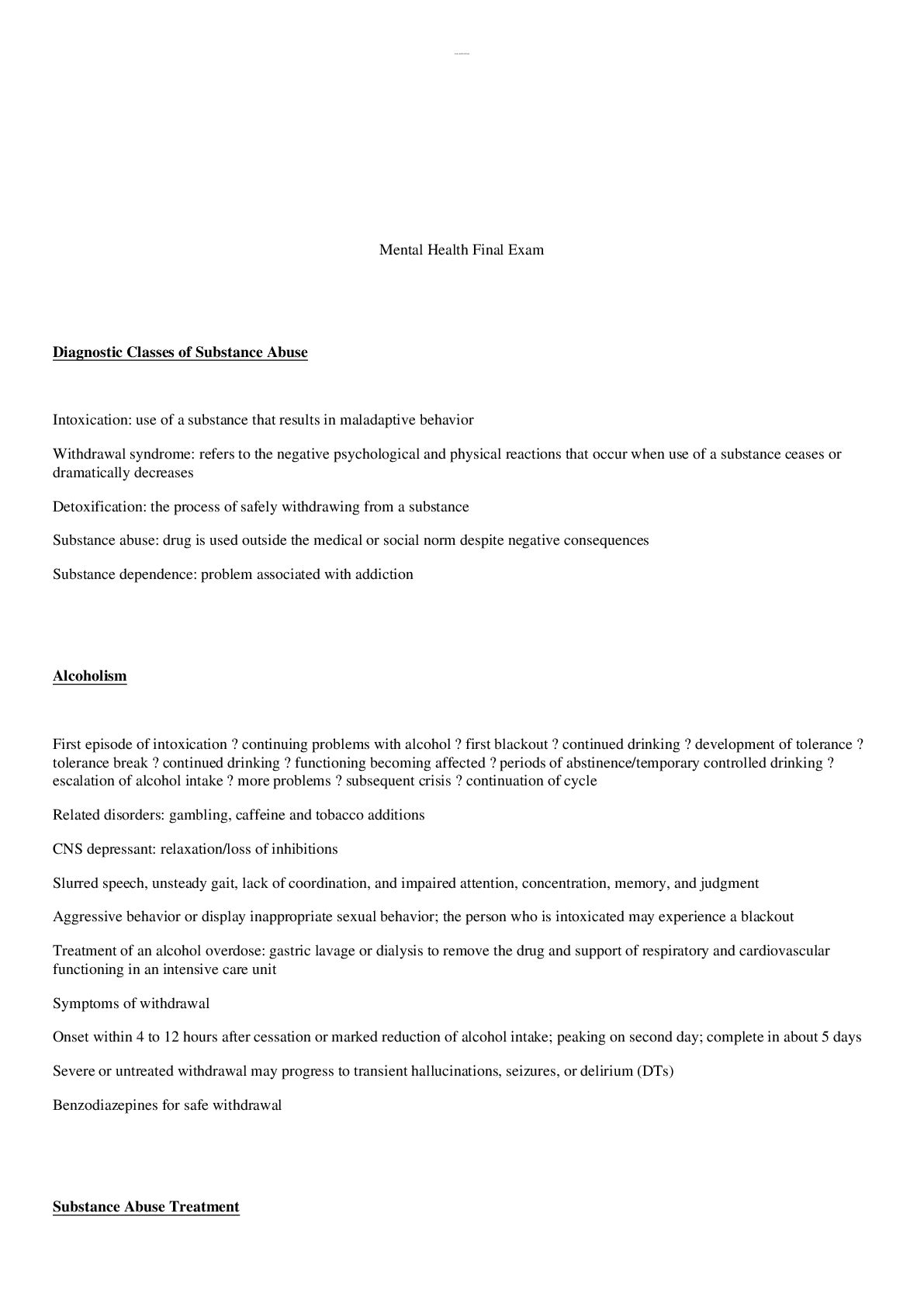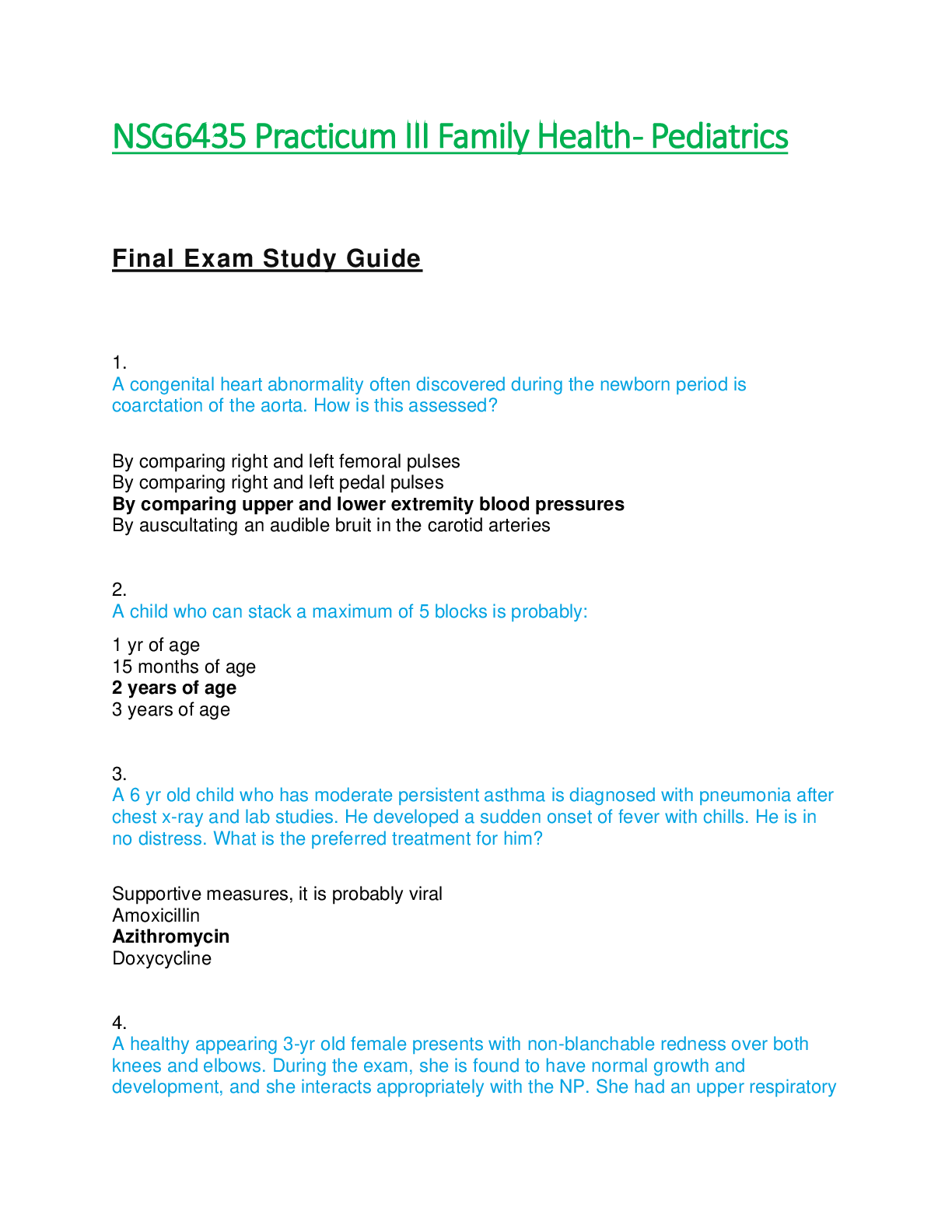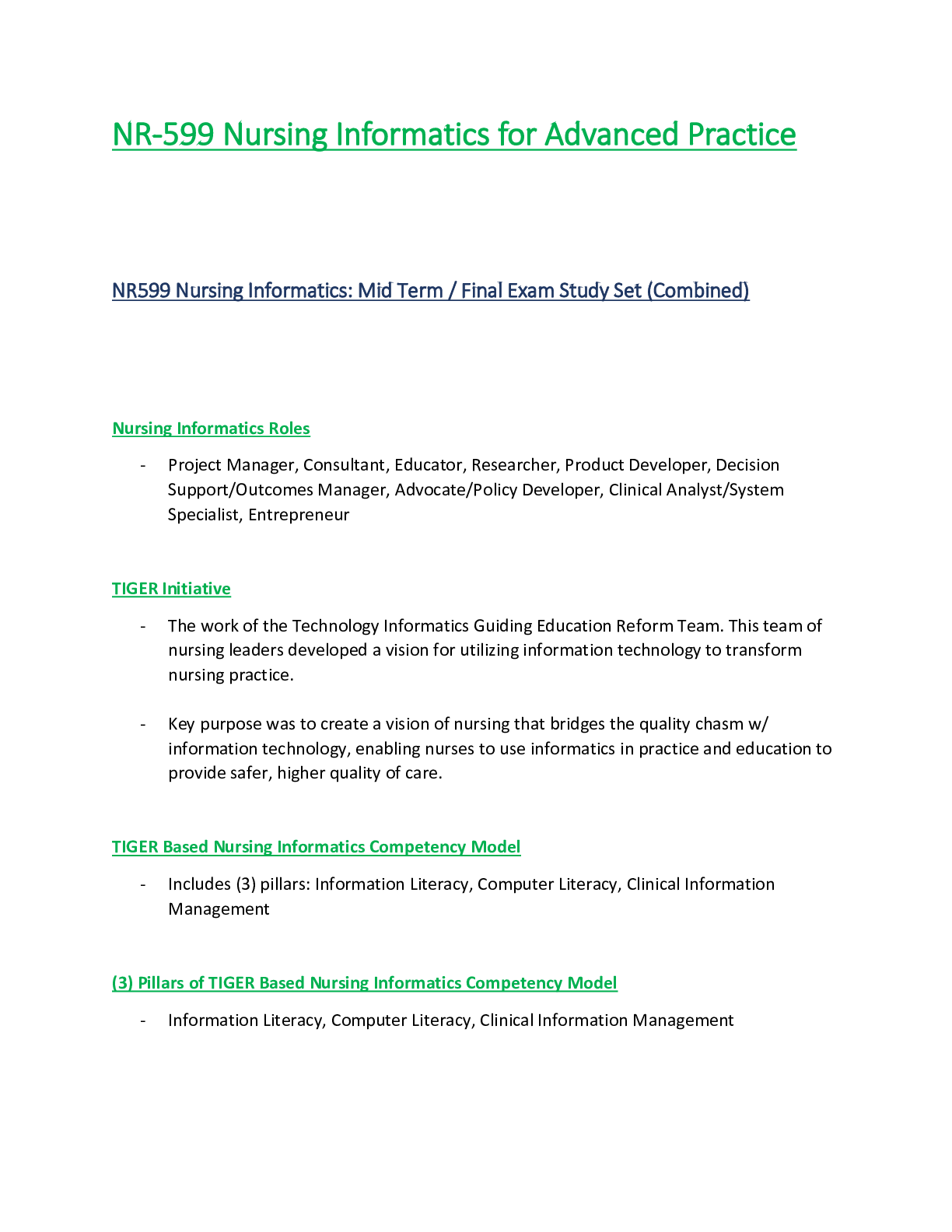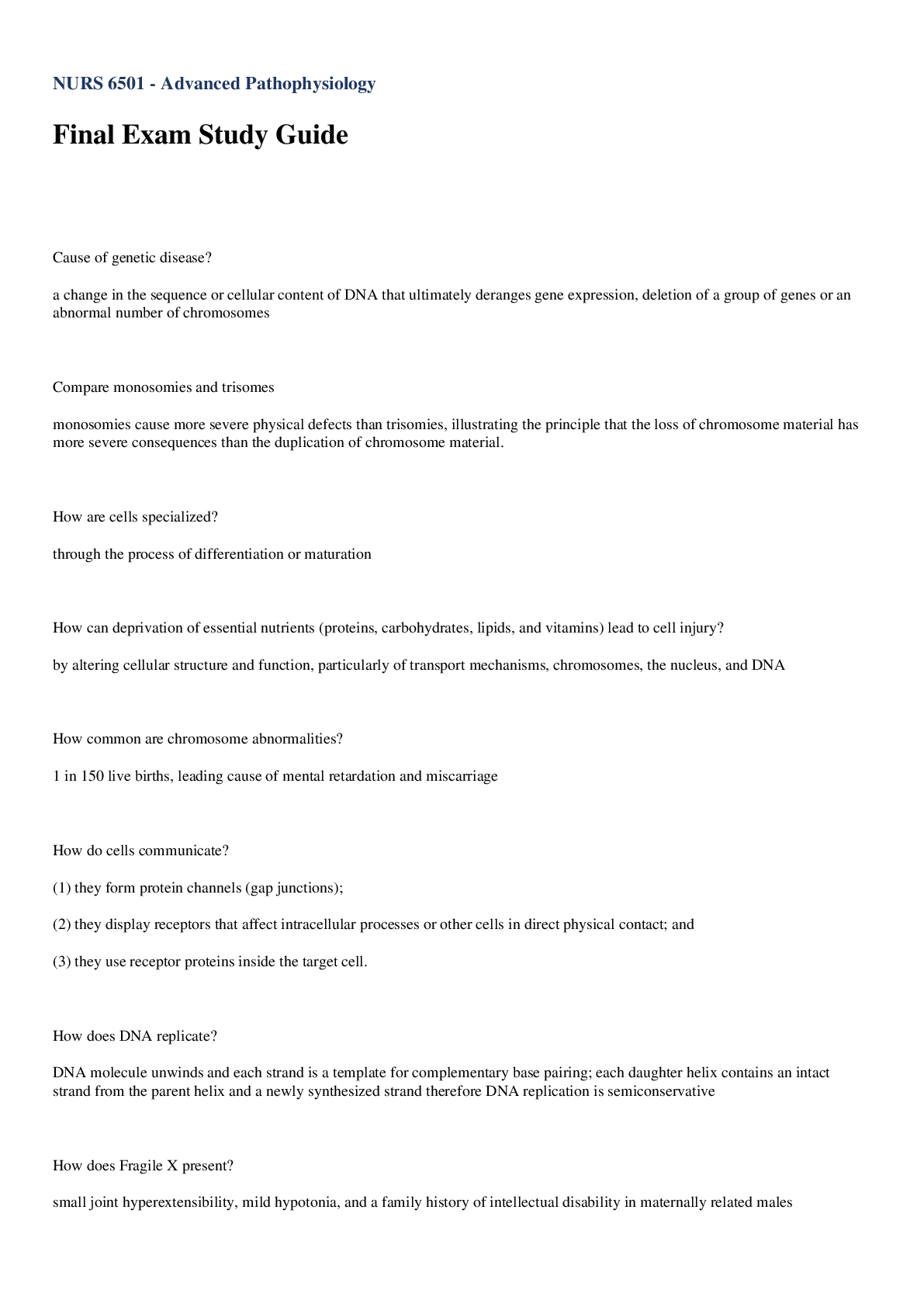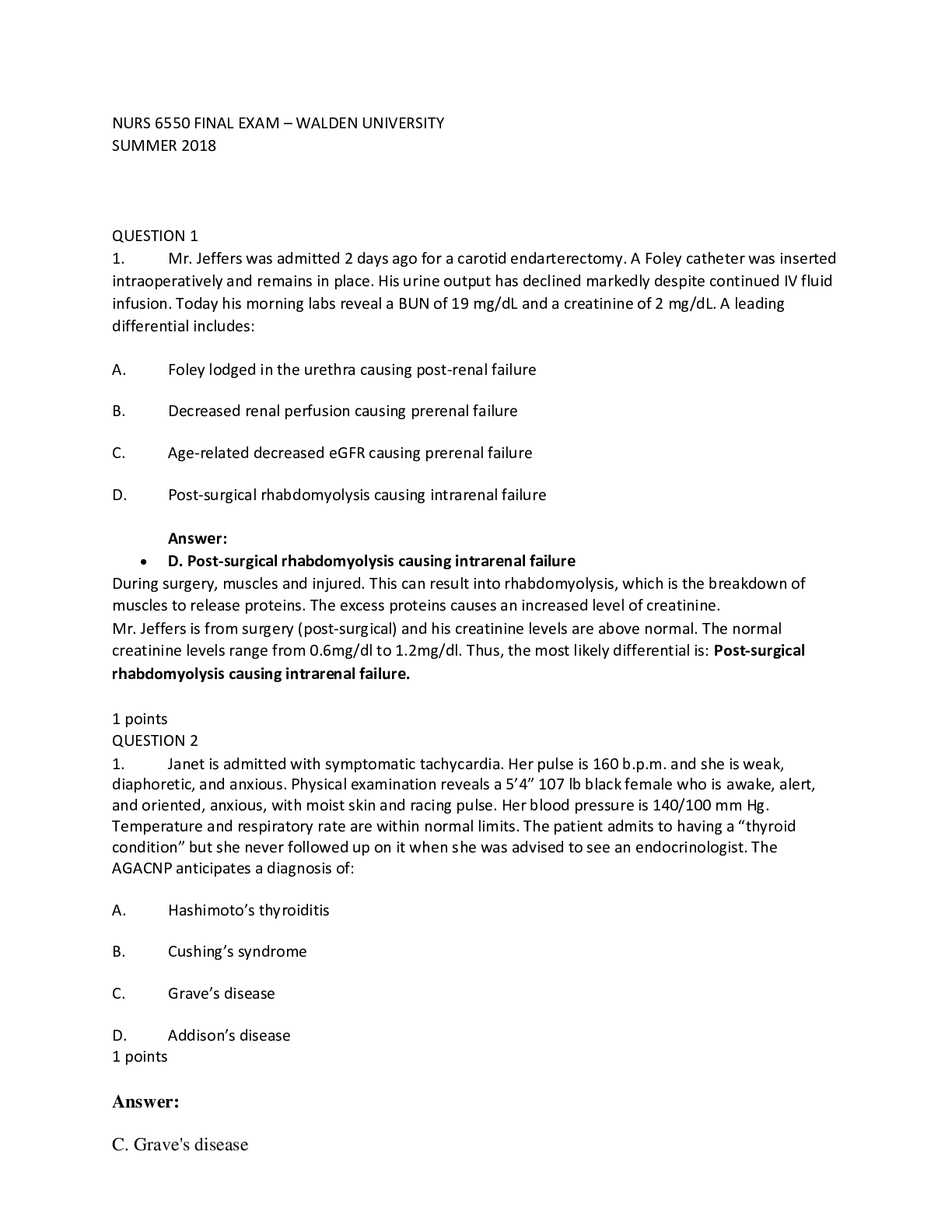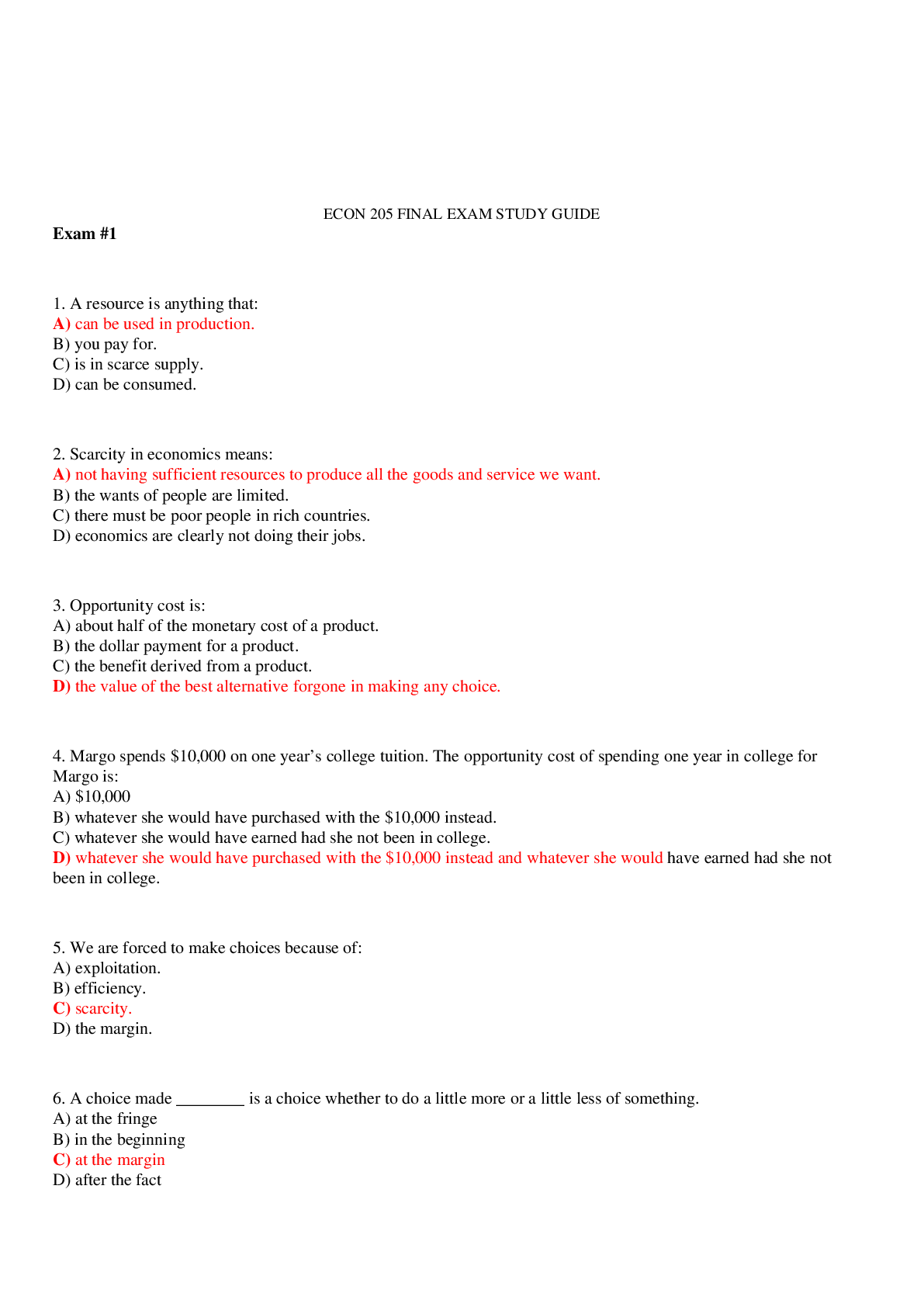Micro Biology > EXAM > BIOD 171 FINAL EXAM STUDY RATED A+ (All)
BIOD 171 FINAL EXAM STUDY RATED A+
Document Content and Description Below
Microbiology is the study of what? Ans- Microbiology is the study of microbes (microorganisms and viruses) and their biological processes. What is the smallest biological unit of life Ans- cell Wh... at is a macromolecule? Ans- A macromolecule is classified as a complex molecule that is composed from smaller subunits. What are the four main types of macromolecules? Ans- Proteins, nucleic acids, lipids and carbohydrates What various functions do proteins have in a cell Ans- Proteins may facilitate the movement of materials in or out of a cell. Some can act as enzymes that catalyze, or speed up, biochemical processes. Others play a structural role while other proteins, such as filaments, enable movement. What are the two major types of nucleic acids and their roles? Ans- There are two major types of nucleic acids: DNA (deoxyribonucleic acid) and RNA (ribonucleic acid). Nucleic acids are chemical molecules that carry genetic information within the cell. DNA contains a vast amount of hereditary information and is responsible for the inheritable characteristics of living organisms. RNA is responsible for deciphering the hereditary information in DNA and using it to synthesize proteins. What is the plasma membrane, and what is it made up of? Ans- The plasma membrane serves the cell as a surrounding barrier that separates the inside of the cell from the outside surrounding environment. The plasma membrane also restricts the movement of materials (water, nutrients, etc) either in or out of the cell, thus allowing a cells to absorb and keep what is needed (influx) while also preventing the escape (out flux) of essential nutrients. The plasma membrane is composed of lipids (hydrophobic hydrocarbons). What are the three main components of carbohydrates? Ans- Carbohydrates are composed of carbon, hydrogen and oxygen atoms. Examples would include, C6H12O6 (glucose) C12H22O11 (sucrose) and C6H10O5 (cellulose). What is the primary difference between prokaryotic and eukaryotic cells? Ans- Eukaryotic cells contain a nucleus, a membrane enclosed region within the cell that contains the genetic material. Prokaryotic cells do not have a nucleus and can be further classified as either Bacteria or Archaea. What are the main morphologies of bacteria? Ans- Bacteria can be described as coccus (round/spherical), bacillus (rod), vibrio (curved rod) or spirillum (spiral/corkscrew). Which group (classification) of microbes is noted for its ability to survive under harsh conditions? Ans- Archaea. They are able to survive in extremely harsh environmental conditions such as high salt levels, acid conditions, high temperatures and oxygen-poor conditions. What are the four main classifications of Eukarya? Ans- Eukaryotic microorganisms are classified as either belonging to Animalia, Plantae, Fungi or Protista. Can viruses be classified as either prokaryotic or eukaryotic? Ans- No. Viruses are considered neither prokaryotic nor eukaryotic. Viruses are not considered living and do not replicate on their own, meaning they must replicate within a host. The lipid bilayer of the plasma membrane is composed of what? Ans- The cell membrane is a bilayer composed primarily of amphipathic phospholipids, meaning they contain a polar hydrophilic (water loving) head group and a non-polar hydrophobic (water fearing) tail region. The lipid bilayer is situated in such a way where the non-polar tail groups face inward thus orienting the polar head groups to interact with water both outside and inside of the cell. What are the primary cellular organelles described in this module? Be sure to know the roles of each. Ans- Ribosomes (protein synthesis), ER (site of protein synthesis), Golgi (protein modification and distribution), lysosomes (waste disposal), mitochondria (ATP generation) and chloroplasts (plants only; site of photosynthesis). What is cellular metabolism? Ans- Metabolism is a controlled set of biochemical reactions that occur in living organisms in order to maintain life. What is the primary function of enzymes, and how are they regulated? Ans- Enzymes speed up chemical reactions. Most notably, the enzyme is not consumed during the reaction and can be used repeatedly by the cell. Enzymes can also be regulated by a cofactor such that in the absence of the proper cofactor, enzymes are inactive while in its presence enzymes are active. What is the difference between catabolism and anabolism? Ans- Catabolism is the process of breaking down larger molecules into useful energy sources whereas anabolism is the building up or biosynthesis of macromolecules from smaller molecular units into larger complexes, most often associated with cellular growth and repair. ATP has the energy to ,BLANK while ADP has the capacity to BLANK energy. Ans- donate; accept Chemotrophs can be subdivided into what two additional subgroups? Ans- Chemotrophs, which acquire energy from preformed chemicals found in the environment, can be divided into either organotrophs (removing electrons from organic molecules such as glucose) or lithotrophs, which remove electrons from inorganic molecules. Chemotrophs utilize which form of phosphorylation? Ans- Chemotrophs use oxidative phosphorylation (as opposed to photo or substrate-level phosphorylation). Oxidative phosphorylation utilizes the energy released by the chemical oxidation of nutrients to reform ATP. What are the three distinct stages in the catabolism of glucose? Ans- Glycolysis is the first step of this process and yields 2 molecules of ATP. Next, by either fermentation (or respiration) 2 additional molecules of ATP can be produced. Last, the electron transport chain (ETC) produces 34 ATP via an oxidative phosphorylation event at the plasma membrane. What are the reactants of glycolysis? Ans- Reactants are defined as any molecules present and involved at the beginning of a specific chemical reaction (ie) glycolysis. In terms of writing out a chemical reaction, the reactants are everything located to the left of the arrow. The reactants of glycolysis are glucose, the co-enz [Show More]
Last updated: 1 year ago
Preview 1 out of 23 pages

Reviews( 0 )
Document information
Connected school, study & course
About the document
Uploaded On
Feb 12, 2023
Number of pages
23
Written in
Additional information
This document has been written for:
Uploaded
Feb 12, 2023
Downloads
0
Views
44


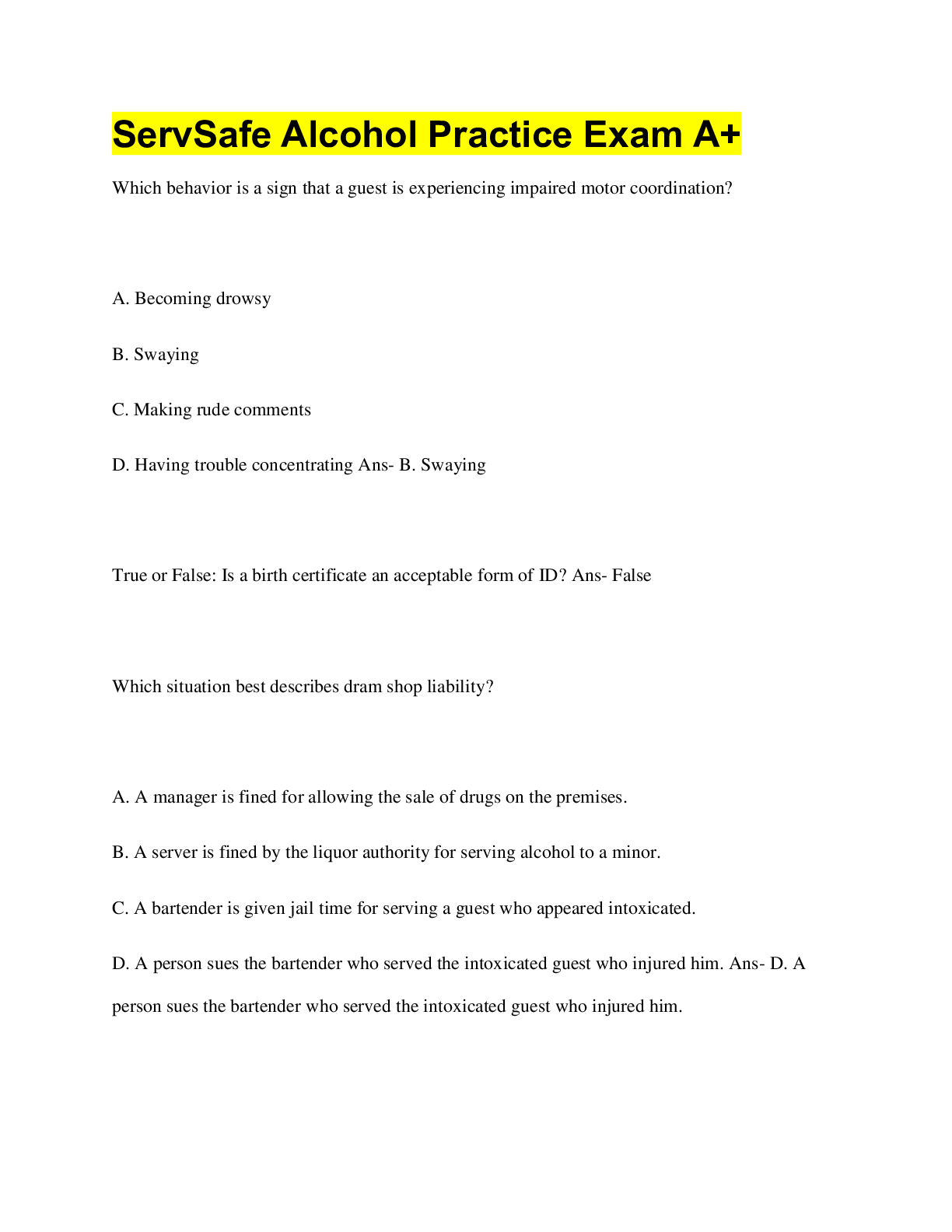
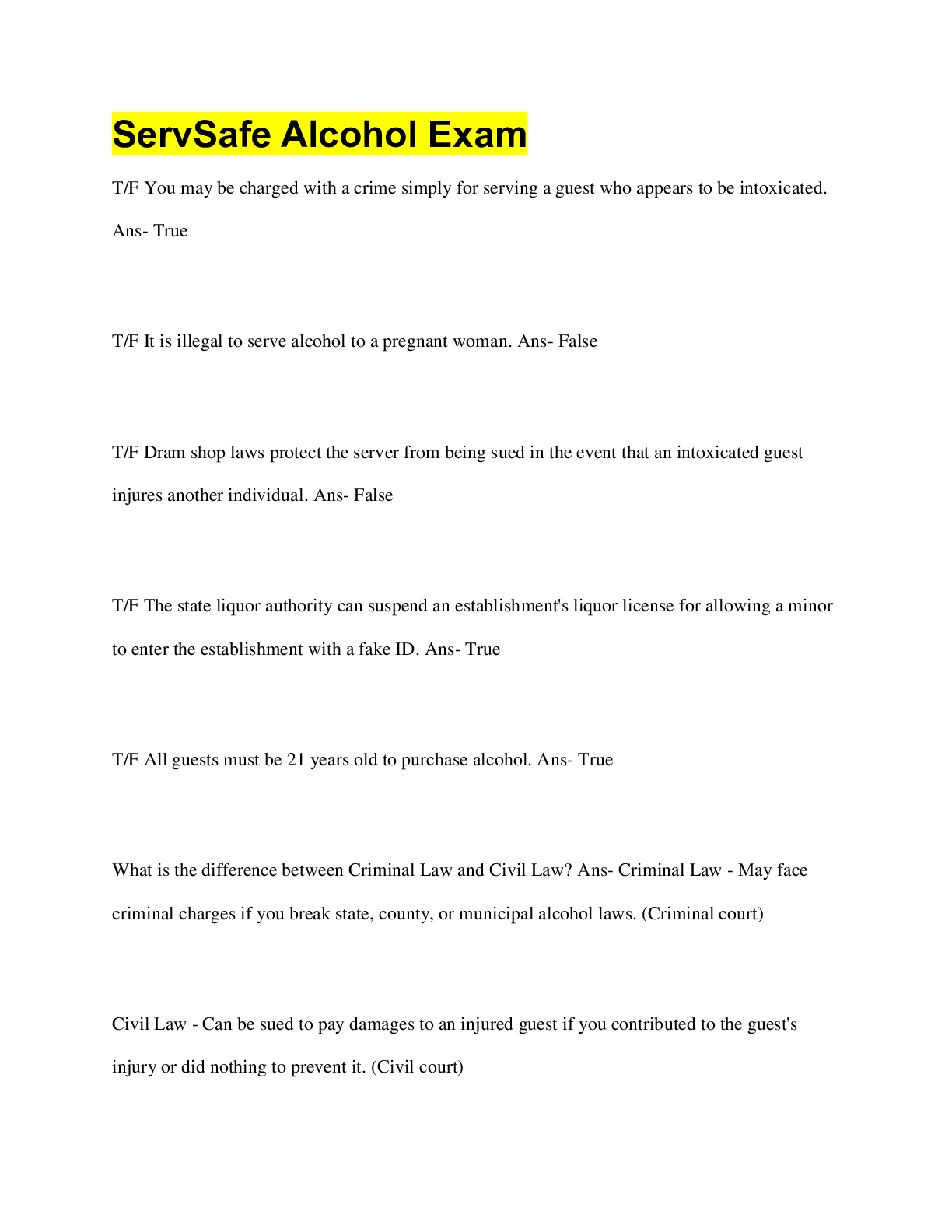
.png)
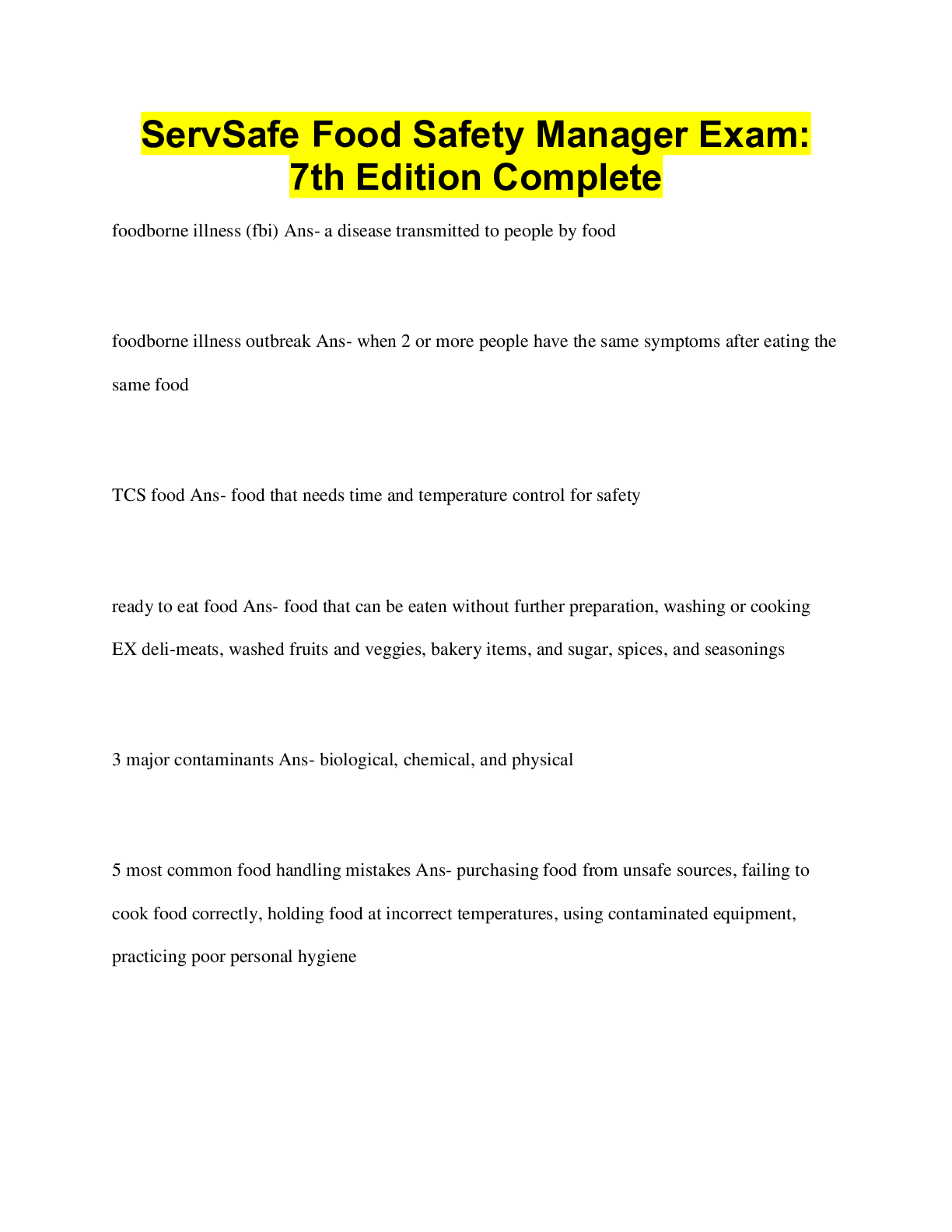
.png)

